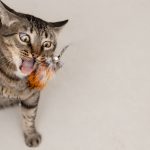Introduction: The familiar crash of a cherished item hitting the floor, courtesy of your mischievous cat’s paw, is a scenario all cat owners can relate to. While it may seem like a mere feline quirk, understanding why cats engage in this behavior is the key to addressing and redirecting it effectively. This guide explores the logic behind cats knocking things over and provides insights on managing and modifying this seemingly playful yet disruptive conduct.

Unraveling the Mystery: Why Cats Push Things Off Tables Delving into the reasons behind a cat’s inclination to push items off surfaces unveils a combination of instinctual behaviors and learned responses.
- Instinctual Predatory Drive:
- Cats, as natural predators, are drawn to fast-moving objects. The act of knocking items off tables mimics their instinct to chase, catch, and interact with agile prey.
- Reinforcement Through Attention:
- Cat owners unknowingly reinforce this behavior by reacting when their feline companions indulge in the act. Attention, whether in the form of talking or picking up the cat, becomes a rewarding response, encouraging the behavior to persist.
- Boredom as a Catalyst:
- Cats left with insufficient stimulation in their environment may resort to knocking things over as a form of entertainment. Boredom and lack of interaction can drive this playful yet disruptive behavior.
Strategies to Halt the Toppled Treasures: A Cat-Parent’s Guide Understanding the root causes of your cat’s tabletop antics is crucial for implementing effective behavior modifications. Here are proactive steps to mitigate and redirect this behavior:
- Environmental Management:
- Strategically place breakables out of reach, using cupboards and cabinets to safeguard fragile items.
- Enrichment for Mental Stimulation:
- Provide engaging alternatives such as horizontal scratchers, scratching posts, and a variety of toys that captivate your cat’s attention.
- Vertical Spaces and Cat Condos:
- Encourage climbing and exploration by integrating tall cat condos and shelves into your living space. These spaces not only serve as exercise spots but also as cozy nap havens.
- Strategic Responses and Attention Control:
- Avoid unintentionally reinforcing the behavior by redirecting your cat’s attention before she jumps onto surfaces. Proactively engage her in interactive play, throwing toys, and using puzzle feeders.
- Mealtime Engagement:
- Make meals more interactive by incorporating food-dispensing toys or hiding treats in cat trees. This engages your cat’s hunting instincts in a positive manner.
Conclusion: Fostering Harmony in Feline Playfulness While the sound of crashing items may be a familiar tune in a cat-filled home, understanding the motivations behind this behavior empowers cat parents to create a harmonious living space. By addressing the root causes, offering engaging alternatives, and redirecting attention, you can transform your mischievous cat’s penchant for knocking things over into a more constructive and enjoyable feline pastime.


